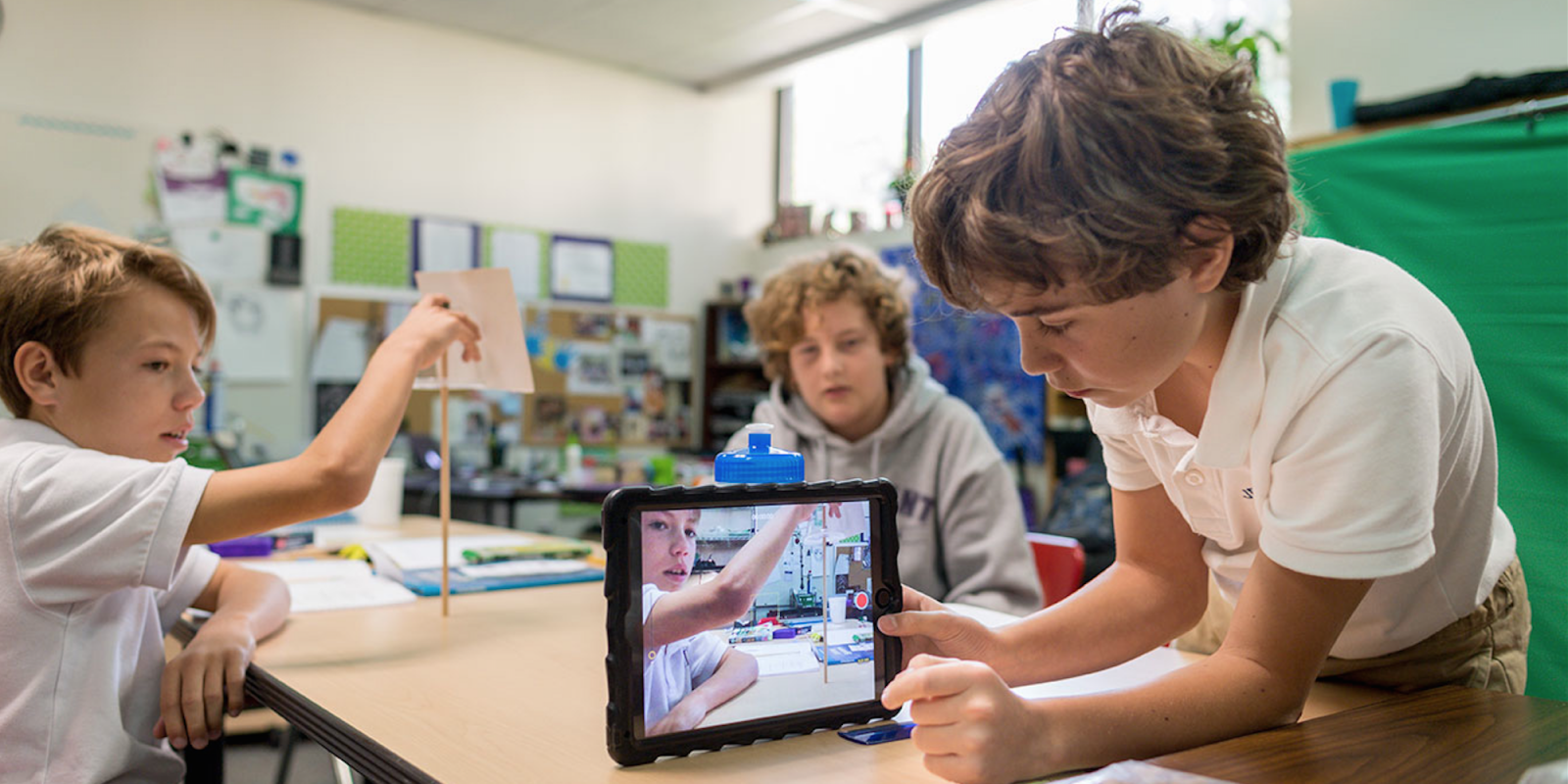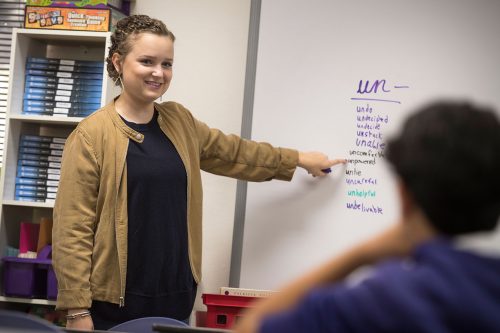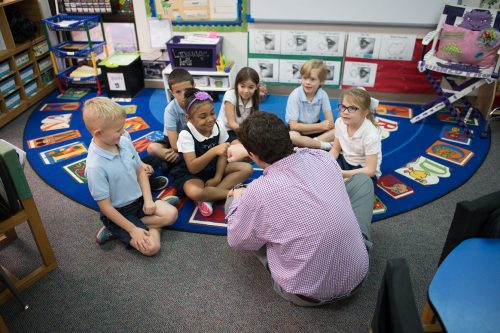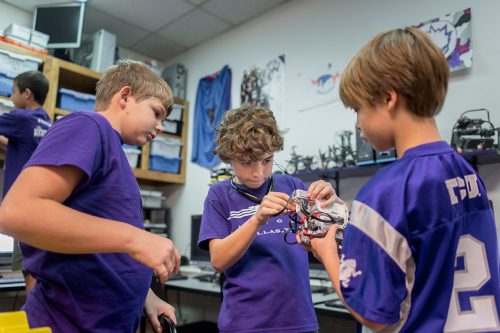

Starpoint School’s Special Education
At age 50, the on-campus lab school is still giving students a chance to shine.
A big, open room in the center of Starpoint School vibrated with excited voices. Using every available chair and space on the floor in the brick building on Stadium Drive, elementary school students worked with TCU education majors during tutoring sessions.
Galen Storey, a then-junior education major in her second semester at the on-campus lab school, conducted a math lesson for three students in a tiled hallway one morning last spring. The 10-year-old boys translated the results of a mock presidential election.
Two students plotted presidential votes on a line graph that sloped down from George Washington to the least-popular candidates. The strongest math student, sitting cross-legged, apportioned equal pieces of a pie graph for the election’s runners-up.

Senior education major Galen Storey explains prefixes to her students at Starpoint School.
Storey tailored the project to each student’s math capabilities. In doing so, she attempted to reach each member of a group of children who learn in atypical ways, which is a commonality among Starpoint students.
Marilyn Tolbert ’96 (MEd ’00, EdD ’10), director of Starpoint, explained the most common way students arrive at the 65-pupil school. After struggling to keep up in traditional kindergarten or first-grade classrooms and receiving a diagnosis of a specific learning disability (dyslexia or attention deficit disorder, for example), children and their parents visit the 50-year-old school seeking help.
Starpoint’s educators pinpoint where incoming students fell behind in mainstream classrooms. “Our job is to shore those cracks up by going back and looking at what the gaps are in learning, and then helping them figure that out,” Tolbert said. The goal is to get the students back to their home schools with renewed confidence for academic success.
“I think the biggest thing that we have … is helping [students] understand that they are smart, and they can do very well,” Tolbert said. “And, they can succeed and do whatever they want.”
Tolbert delivers an even more optimistic message to parents: Once addressed, learning differences often turn into creative advantages. “I always tell them, ‘Your children are the ones that everybody else is going to be working for because they’re the entrepreneurs. They’re the Steve Jobses. They’re the imagineers.’”
“I think the biggest thing that we have … is helping [students] understand that they are smart, and they can do very well … They can succeed and do whatever they want.”
Starpoint director Marilyn Tolbert
HELP FOR A GRANDSON
Starpoint started as a love story, said Tolbert, who joined the school in 2003.
Fort Worth philanthropists M.J. and Alice Neeley became heartbroken as they watched their grandson, Russ Nettles, struggle through school in the early 1960s.
“Mr. and Mrs. Neeley were so concerned. They had been visiting all over the country, trying to find some type of school that would help,” said Columba Reid, a five-decade colleague of M.J. Neeley.

The Yearning to Know statue in front of Starpoint School was dedicated in 1990. M.J. Neeley commissioned the work in honor of his wife, Alice.
The search led to Margaret Slater, a special education expert at a New York school called Starpoint. Under Slater’s tutelage, Reid said, Russ blossomed. Inspired by Slater’s work with their grandson, the Neeleys imagined a similar school in Fort Worth.
M.J. Neeley “was all for the underdog, always,” Reid said, and envisioned a place where children with learning challenges would receive appropriate instruction to help them overcome those obstacles. Alice Neeley, however, prioritized teaching aspiring educators the practice of special education so they could help struggling students.
The couple enticed Slater to Fort Worth in 1966 with the promise of a school with a twofold purpose. They established a school for 12 students in a barracks building behind the TCU library. The Neeleys then decided to build a dedicated building on Stadium Drive.
Starpoint School moved into its current home on campus in 1978, and the Neeleys were regular visitors, even celebrating M.J.’s October birthday every year with the students. “He just loved it here and wanted to serve the children,” said Robin Davis, a teacher at Starpoint for 33 years.
Although Davis is one of the longest-tenured teachers on the school’s 10-person faculty, most of her colleagues have been with Starpoint for 20 years or longer. “They all say they’re never going to retire,” Tolbert said.
A SCHOOL FOR INDIVIDUALS
Now at the half-century mark, Starpoint is bursting at the seams with eight classes spread across levels, which are analogous to traditional grades. Students shift levels to suit their rates of progress in different subjects. The flexibility is an aspect of individualized instruction, which includes experimenting with different curriculum models until each child understands the material presented.

An education major helps a Starpoint student with an activity on a tablet.
Starpoint teachers work to meet state education standards, but the 10-to-1 student-to-teacher ratio allows for more tailored instruction than the students would find in a mainstream school. “Every class is different,” Tolbert said. “Every kid is different each year.”
Most Starpoint students are frustrated by not “getting it” prior to enrolling at the campus school.
“We’ve got kids here that have 140 IQs,” Tolbert said. “Some of them, when they first got here, couldn’t even recognize their names in print.”
Reading was nearly impossible for Jack Coulborn, a sixth-level student, before he arrived at Starpoint. In first grade at an elementary school in Fort Worth, he was diagnosed with dyslexia.
But, Jack said, reading still did not make sense, which is why the lessons were frustrating. “I got to the point where I just whacked everything off the table because I couldn’t take it anymore.”
Jack’s father, Pete Coulborn ’94, also ran out of patience. Public school teachers had done everything possible to try to help his son read. Coulborn took Jack for an observation day at Starpoint.
Jack felt at home at the campus school because of the family atmosphere, where he said students with learning differences were not outsiders.
The following fall, Jack enrolled as a second-level student at the campus school. After two weeks at Starpoint, Coulborn said, Jack offered to read to him. “I literally had to get up and go in the other room because I almost cried.”
Today, Jack is an active reader whose favorite book is Galactic Hot Dogs (Aladdin, 2015). He’s also a capable writer. A wall at the school last spring featured personal essays describing the talents of their fifth-level writers. Jack’s piece explained his love of sailing. His classmates wrote about replicating buildings with Legos, riding a long board and reading a 400-page book in a single weekend.
MAKING LEARNING FUN
Starpoint gives students leeway to explore their interests in ways that work for their brains, and a collection of science projects in the school’s central room exemplifies this approach. One project was an investigation of the association between vehicle weight and battery life in electric cars. Another was an analysis of whether dogs preferred a specific type of toy. (Yes, that would be noisy toys.)
“We’ve got kids here that have 140 IQs. Some of them, when they first got here, couldn’t even recognize their names in print.”
Marilyn Tolbert
Like mainstream schools, Starpoint offers classes outside the core academic subjects. A full-time visual arts teacher integrates creative expression into subject material from other classrooms, and regular volunteers from The Artist Outreach teach music.
The school has a robotics lab, where upper-level students learn programming basics. “Where [the students] really thrive is technology, art, music,” Tolbert said.
To break up the learning sessions, Starpoint students take four 15-minute outdoor brain breaks each day. The activity sessions are helpful for kids with attention issues, said Amanda Young ’09, the adapted physical education teacher at Starpoint. She also leads daily morning calisthenics. After dispelling excess energy, Young said, students can focus on challenging subjects.
Jack agreed that the regular activity sessions helped him. Classwork was a source of “a lot of stress sometimes.” He often relied on moral support from teachers at Starpoint. “If I’m having too hard of a time, sometimes they could comfort me, and it helps me,” he said. “Or, they could just give me some determination.”
In addition to encouragement, Starpoint’s teachers, all of whom hold master’s degrees in education, use approaches beyond traditional classroom instruction.
Kim Payne, assistant director of laboratory schools at Starpoint and a third-level instructor, wanted her students to isolate the main ideas from Mummies in the Morning (Random House Books for Young Readers, 1993).
Payne’s students drew a scene on a notecard to represent each chapter and summarized the action in the book. One student narrated how a “slick black cat” followed the protagonists from a backyard treehouse to a funeral parade in ancient Egypt, where a ghost queen informed them they might be stuck. Everything worked out for the fictional children in the end, as summarized on the student’s final card: “Jelly sandwiches.”
TOMORROW’S TEACHERS
While special-education experts such as Payne know how to reach a child with an atypical learning style, Tolbert said many educators in mainstream schools have limited experience teaching the students. “There are kids with learning differences everywhere, not just our little school,” she said.
Starpoint fulfills Alice Neeley’s vision for the school in welcoming TCU students, primarily education majors but also students in kinesiology, nutrition, music and dance, to work with the schoolchildren. “The Starpoint students know that they wear two hats when they come to school,” Young said. “They come to school to learn, but they also come to school to teach.”

Michael Faggella-Luby, associate professor of education, works with Starpoint students.
Storey came to Starpoint while recovering from chemotherapy to treat rhabdomyosarcoma, a rare form of pediatric cancer. (She is in remission.) She wanted to teach but had no initial interest in special education. She ended up at Starpoint because its small student body was safer for her immune system.
For a group of fifth-level language-arts students, Storey invented a project based on the book The Miniature World of Marvin and James (Square Fish, 2015), in which Marvin the beetle lives in a tiny house.
Storey wanted the students to imagine a room for Marvin and instructed them to write about its details, then build the shoebox room with paper clips, cotton balls and other items. But writing and then creating was not an intuitive process for many of Storey’s language arts students, so she reversed the steps by allowing them to build the rooms first. “It was definitely a learning process for me because those kids just learn and work so much differently,” she said.
Undergraduate education majors at TCU must specialize in English as a second language or special education. If they opt for the latter, junior majors spend one spring semester day each week working with Starpoint students as a component to the junior-level course “Academic Success in Special Education.”
“Can you think of any better way than to go into a class on Monday, learn about how you should approach instruction for kids with disabilities, and then on Thursday, go into a school and work one-on-one?”
Michael Faggella-Luby, associate professor in the College of Education
Teaching experience, whether at Starpoint or another school, is “at the heart of the entire program in the College of Education,” said Michael Faggella-Luby, associate professor of education. “Can you think of any better way than to go into a class on Monday, learn about how you should approach instruction for kids with disabilities, and then on Thursday, go into a school and work one-on-one?”
Starpoint also selects two graduate students in education who are assigned to the school for two semesters as associates. Stacey Cherry Hardwick ’07 MEd was once an associate. “I learned more there than I did teaching anywhere,” she said. Afterward, Hardwick taught at Fort Worth Country Day school before leaving to become an educational diagnostician.
Hardwick now helps students and their families identify learning differences. All teachers, whether or not they are working with schoolchildren with dyslexia or attention deficit disorder, can learn from the Starpoint way, she said. “You need to tailor everything, no matter where you are.”
“It’s really helped us all to have a greater appreciation for each other, have a greater appreciation for education and to have a greater appreciation for each other’s differences.”
Pete Coulborn '94
AIMING HIGH
On a weekday last spring when a group of education majors worked mostly one-on-one with students, Starpoint was a cauldron of learning and teaching.
Allison Moore, a junior education major, conducted a history lesson on the American Revolution with a 10-year-old girl in a purple T-shirt.
“Do you know what rebellion is?” Moore asked.
The girl shook her head.
“What is something your mom tells you to do that you don’t want to do?”
“Clean my room,” the girl answered.
Moore nodded. “If you don’t do it, that’s rebellion.”
The girl grew pensive before asking, “So my mom is like the English government?”
Moore then introduced the girl to nuances of the word rebellion.

Jack Coulborn (center) and other upper-level students at Starpoint School have the opportunity to learn about robotics while practicing for a competition in the First Lego League.
Inside a classroom at Starpoint, Kaitlin Barry, a junior education major, watched an online video about static electricity with a third-level student who was interested in science.
The concept of electrons and protons was a lot of information, Barry told the boy. “But since you’re curious and a hard worker, you can handle it,” she said.
After the video, Barry and the student walked across the carpet in socks and then tested the electrical charges of doorknobs and wooden shelves. “I feel the electrons flowing out of me,” said the boy, his hair reaching toward the ceiling.
Taking a quick break from the election graphing exercise, Storey offered advice to a classmate, assuring the student teacher that trial and error was a normal approach. She urged the classmate to keep adapting the lesson plan until the student understood the material.
“I think what I loved so much about [Starpoint] was how challenging it was, and I love challenges,” Storey said. She is in the accelerated academic program in the College of Education. Upon graduation from TCU, and five years of study, Storey will hold bachelor’s and master’s degrees in education.
The aspiring teacher who once had no interest in special education changed her mind after spending time at Starpoint. “This is exactly what I want to do,” Storey said. “So, without getting sick and having the opportunity to be placed in there for extra time, I wouldn’t have figured out what I wanted to do.”
Starpoint had a transformative effect on the Coulborn family. The school “changed everybody in our family,” Jack’s father said. “It’s really helped us all to have a greater appreciation for each other, have a greater appreciation for education and to have a greater appreciation for each other’s differences.”
Jack will attend seventh grade at a different school in the fall. His career interests include video game design, robotics and graphic arts. No matter where he goes in life, Jack said his five years at Starpoint will stay with him. “I’ll probably be a lot more confident.”

Your comments are welcome
1 Comment
When you see this it may be 2020 but for me it’s 2019. This school was a blessing from god for me. you have no idea how much i love this school. if you ever think about going here or taking your child DO IT. this is the best school in the world. and that’s the truth.
-Jack Coulborn
Related reading:
Features
Adam Fung’s Uncommon Arctic Adventure
The art professor is acting as an Arctic ambassador and filmmaker after his 19-day residency in the Far North.
Features
KinderFrogs Overcome Developmental Delays
Preschoolers with Down syndrome prep for traditional classrooms.